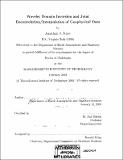| dc.contributor.advisor | M. Nafi Toksöz. | en_US |
| dc.contributor.author | Kane, Jonathan A. (Jonathan Andrew), 1973- | en_US |
| dc.contributor.other | Massachusetts Institute of Technology. Dept. of Earth, Atmospheric, and Planetary Sciences. | en_US |
| dc.date.accessioned | 2010-10-29T18:02:35Z | |
| dc.date.available | 2010-10-29T18:02:35Z | |
| dc.date.copyright | 2003 | en_US |
| dc.date.issued | 2003 | en_US |
| dc.identifier.uri | http://hdl.handle.net/1721.1/59651 | |
| dc.description | Thesis (Ph. D.)--Massachusetts Institute of Technology, Dept. of Earth, Atmospheric, and Planetary Sciences, 2003. | en_US |
| dc.description | Includes bibliographical references (leaves 168-174). | en_US |
| dc.description.abstract | This thesis presents two innovations to geophysical inversion. The first provides a framework and an algorithm for combining linear deconvolution methods with geostatistical interpolation techniques. This allows for sparsely sampled data to aid in image deblurring problems, or, conversely, noisy and blurred data to aid in sample interpolation. In order to overcome difficulties arising from high dimensionality, the solution must be derived in the correct framework and the structure of the problem must be exploited by an iterative solution algorithm. The effectiveness of the method is demonstrated first on a synthetic problem involving satellite remotely sensed data, and then on a real 3-D seismic data set combined with well logs. The second innovation addresses how to use wavelets in a linear geophysical inverse problem. Wavelets have lead to great successes in image compression and denoising, so it is interesting to see what, if anything, they can do for a general linear inverse problem. It is shown that a simple nonlinear operation of weighting and thresholding wavelet coefficients can consistently outperform classical linear inverse methods in terms of mean-square error across a broad range of noise magnitude in the data. Wavelets allow for an adaptively smoothed solution: smoothed more in uninteresting regions, less at geologically important transitions. | en_US |
| dc.description.abstract | (cont.) A third issue is also addressed, somewhat separate from the first two: the correct manipulation of discrete geophysical data. The theory of fractional splines is introduced, which allows for optimal approximation of real signals on a digital computer. Using splines, it can be shown that a linear operation on the spline can be equivalently represented by a matrix operating on the coefficients of a certain spline basis function. The form of the matrix, however, depends completely on the spline basis, and incorrect discretization of the operator into a matrix can lead to large errors in the resulting matrix/vector product. | en_US |
| dc.description.statementofresponsibility | by Jonathan A. Kane. | en_US |
| dc.format.extent | 174 leaves | en_US |
| dc.language.iso | eng | en_US |
| dc.publisher | Massachusetts Institute of Technology | en_US |
| dc.rights | M.I.T. theses are protected by
copyright. They may be viewed from this source for any purpose, but
reproduction or distribution in any format is prohibited without written
permission. See provided URL for inquiries about permission. | en_US |
| dc.rights.uri | http://dspace.mit.edu/handle/1721.1/7582 | en_US |
| dc.subject | Earth, Atmospheric, and Planetary Sciences. | en_US |
| dc.title | wavelet domain inversion and joint deconvolution/interpolation of geophysical data | en_US |
| dc.type | Thesis | en_US |
| dc.description.degree | Ph.D. | en_US |
| dc.contributor.department | Massachusetts Institute of Technology. Department of Earth, Atmospheric, and Planetary Sciences | |
| dc.identifier.oclc | 52711560 | en_US |
